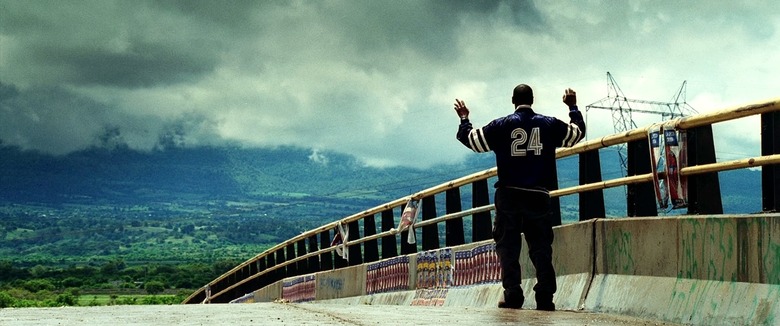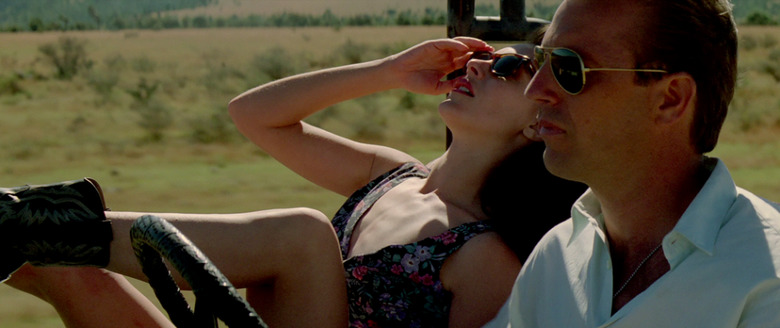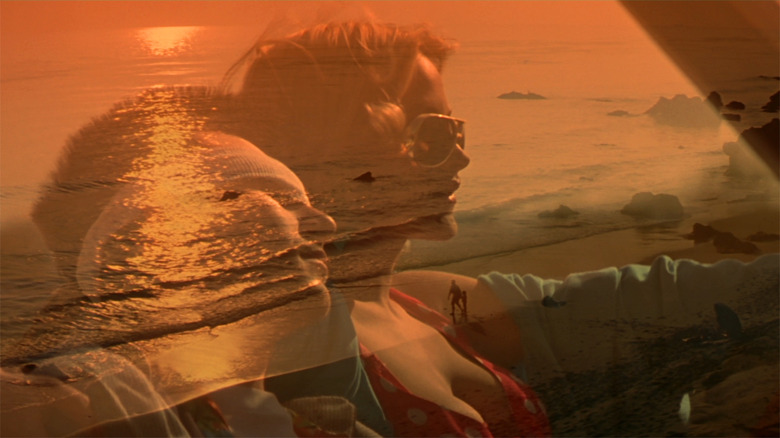Three Great Tony Scott Audio Commentaries
I miss going to the movies and buying a ticket for a Tony Scott movie. There's no voice and style like his in the theaters these days. When big-budget movies come across as interchangeable sometimes, a commercial director who polarized and told stories with aggression and grit is missed. Talk about a director who knew how to create momentum and atmosphere!
Scott also knew how to make some grimy worlds visually appealing and immersive without glossing up unpleasant subject matter. During Scott's best commentary track, for the thriller Man on Fire, he said, "I want to touch these worlds." Whatever world Scott was depicting, he tried to stay honest to it. His eye for attention-to-detail is impressive in every track.
Like Scott's brother Ridley, he not only directed landmark and influential films, he also kindly recorded many exceedingly high-quality commentaries for our pleasure throughout his rich and varied career. If you want a nice dose of honesty, humor, and passion, look no further than these tracks, which are sometimes bittersweet to hear now that he is no longer with us.
Man on Fire
Why Listen: If you want to know what it's like working with Denzel Washington – and not just how great he is to work with – then listen to this track. When Denzel Washington was in his trailer, he was Denzel Washington, but when he stepped out, he was John Creasy. The actor generally stayed in character during the shoot. The movie was shot chronologically, so Washington even distanced himself from Dakota Fanning at the start of the shoot. When the characters became closer, they both started to improvise often. The most meaningful moments in the movie, according to Scott, were Fanning and Washington's improvisations. Scott knew they were "so good and honest" the relationship would never turn corny. Along with a nice constructive look at the performances, Scott shared his knowledge of Mexico, Italy in the '80s, and famous kidnapping cases, and that information alone makes this commentary track fantastic.What's Said: Man on Fire is a movie that continues to age well, A part of the reason why is perhaps the style of the movie, which can go from dreamlike to nightmarish with some unforgettable imagery. There's an ethereal, atmospheric quality that won't date this movie anytime soon.
Scott explained how such a distinct look was created for the thriller:
We used a lot of different cameras, like 1910 hand-cranked cameras with what we call reversal stock, which I call heightened reality. It strengthens the blues in the sky, the blacks, the whites, the colors. We did that on a hand-crank camera and then put it through a process called cross process, which gives an even more heightened reality – stranger, more contrast, and vivid color. The opening title sequence doesn't just give you a flavor of the story but to give you a flavor of the look of the movie.
The director later added why he tended to use multiple cameras:
People always criticise the studio, because it means money, and I'm criticized by the press, "Tony Scott can't shoot without 26 cameras." It's not true, an over-exaggeration. I always shoot a dialogue sequence with at least two cameras, because the best use of multi-cameras isn't how much coverage you get of actions sequences, it's how few times you shoot actors in order to get a great performance. It's very hard for me with one camera to go back in for coverage, like, "Can you repeat that moment?" Multiple cameras are a real way to cover those moments, so you don't have to go in for those extra little pieces you thought you missed. Spontaneity and improvisation is almost impossible to repeat, so that's where these multi-cameras help me out.
A Day on the Job: The most intense sequence in the 2003 film is the kidnapping sequence, which Scott built to with a creeping sense of tangible dread. The director wanted to get in Creasy's mind with the sequence:
The kidnapping I didn't want to make feel like a normal shootout. Right now, it feels part-documentary, part-opera. The opera comes from being in Denzel's point-of-view, seeing it and feeling it from Denzel's point-of-view. I used a mixture of different camera techniques like we talked about earlier – the hand-cranked cameras, different stocks, and sped up. We're shooting at 100fps on certain pieces, and 6fps on other pieces. It's a gamble. What's so great, I now have enough experience to have an understanding of film. When I'm doing things I can anticipate what I need. When I look through the camera, I know what stock we should be shooting on.
Trivia: When the project was in the works in the '80s, Marlon Brando was the first choice, but he thought he was "too heavy" for all the action. Then the role went to Robert De Niro, who was attached to star when the story was set in the former kidnapping capital of the world, Italy. Ultimately, the great Scott Glenn ended up starring in the 1987 take on the story.
Revenge
Why Listen: If there's one word that's spoken most frequently in Scott's commentaries, it's "sexy." He used the word to describe Anthony Quinn, Madeleine Stowe, and a few of Revenge's scenes – but he also used the word to describe his work. As someone who had experienced a forbidden romance, the director related to the story and wanted to turn up the heat with his locations, characters, and atmosphere. While Scott watched his preferred cut during the commentary, he laid out how he wanted to get back to his original intent and cut together a movie that's sexier, more violent and instinctual. Like his brother Ridley, Tony Scott was all about instinct. He always trusted his instincts, and even admitted when they were wrong. Scott was blunt about his work and others, including the producer of Revenge responsible for releasing the safer theatrical cut and delaying the release of the director's cut.What's Said: One note Scott consistently got from the studio? Take it easy on the smoke. In the '80s, Scott's movies had no shortage of smoke and natural light. Scott thought it was right for Revenge and other movies, especially for the time and what he wanted:
The movie, in one way, looks a little dated. I tended to use a lot of smoke to create atmosphere, and that was one of my trademarks: smoke and strong light through curtains. That was on my first movie The Hunger a big trademark. Here, I use it in moments in time I was trying to identify with the love story. It became something [director] Adrian Lyne and myself, back in my commercial years in the late '70s and early '80s, sort of honed and perfected, and a lot of people have copied us. Now it feels like it comes from a different era, but that particular look is very complimentary for the feel of this story.
On Beverly Hills Cop II, he thought he went too far with the smoke and edge, but with Top Gun, he was confident it worked. He perfected the look with cinematographer Jeffrey L. Kimball, who shot many of Scott's commercials and films. Before making a movie, Scott would shoot a commercial and try out some ideas he had in mind for his film.
A Day on the Job: As shown by Scott's movies, especially his most ferociously shot and cut ones, he was aiming for adrenaline and speed. Even when he was shooting a dialogue-heavy scene, he wanted to move fast, which he felt brought out some of his best work as a filmmaker. One reshoot for Revenge reminded Scott of why "sometimes time is the enemy of creative spontaneity":
This scene we shot [with Kevin Costner and Stowe] on a beach in Mexico. Through overanalysis wit the studio, we were forced to rewrite it and reshoot it in Malibu. It's funny, when I look at the spontaneity of the versions we shot in Mexico and Malibu, the spontaneity was lost [in the latter]. The instinctual aspect between the actors became talked to death; it didn't have that same danger or sexuality or edge to it the original scene had. The original scene we shot in less than a day; the reshot scene took us two days. Sometimes time is the enemy of creative spontaneity because you have too much time to think, analyze, adjust, work, and reword. With the original version, we shot it on the run as the sun was going down. Whatever it was, with that speed and spontaneity, Kevin and Madeleine found their moments in time with each other, which I think are very poignant and sexy moments with what they're about to do.
The studio wanted the scene to have more backstory and more words between Costner and Stowe. The original cut had significantly more backstory, but Scott found most of it unnecessary. He knew the character's behavior and interactions were enough to suggest backstory.
Trivia: Scott initially wanted Hans Zimmer to compose the score, but a producer wasn't onnboard because of Zimmer's "inexperience."
True Romance
Why Listen: If there's one movie Scott sounded the most confident in as a filmmaker, it's this classic Quentin Tarantino-scripted love story. He immediately fell in love with the characters, the push and pull sort of tone, and perverse sense of humor. Except for the ending, the director shot the script almost verbatim. While the director is mostly talked about for his signature visual style, his focus was on his characters. Like Scott's other commentaries, he went into all the nuances of a character and scene, and in this case, he must've had a ball doing so. The characters crack him up more than a few times. It's a thorough, often funny commentary that covers everything one would want to know about the making of True Romance.What's Said: Scott always gave credit to his cast and crew, and with True Romance, he gave most of the credit to Tarantino. The director believed most movies weren't as character driven as Tarantino's work. The dark comedy was unique to him, and it was unique enough to make it the first movie where all he had to do was "support what was on the page":
What was unique about this script was I went out to what I regard as some of the best actors in the world. Everyone wanted to do it. They wanted to come to the set and just do the words that were on the page. Normally when you do a movie, people come to the set and want to rethink the characters and the words. Everyone in this cast wanted to do the words on the page, which I applaud Quentin for. People say to me, "God, it's such a great movie," but honest truth is, I gotta give the real applause to Quentin Tarantino because he's the guy who put it on the page. This was the first movie where all I did was to support what was on the page, in terms of my casting, my look, and my styling and how I shot the movie. It's a much easier process when you have a blueprint you're confident about.
Scott read the script in Italy after finishing up The Last Boyscout. Again, the only major tweak Scott made was to the ending to keep Clarence alive. While Tarantino initially felt Scott was selling out a little bit at the end, according to Scott, the director admitted he was a romantic, wanted to see these kids live, and it felt right for the story.
A Day on the Job: Characters talking on phones isn't always the cinematic material. In the hands of Tony Scott, though, it usually was. When Clarence is making a drug deal over the phone at six flags with big-time movie producer Lee Donowitz (Saul Rubinek), the director still wanted the high energy he loved and divided critics:
Here again is the obligatory phone call, which you try to find a fresh way of doing. You got a guy on the phone in a Porsche, you got the other guy on a payphone, so how can I do this a little bit different? So the guy in the car, it's harder to move the camera, so it's more static. With Christian, we got at a phonebox at six flags by Magic Mountain. I did a circular track around Christian, so the background and environment is always changing, and it's a contrast to Sam in the Porsche. No matter what I do with the camera, the dialogue and characters are so strong and well-constructed by Quentin all I can....To be honest, I probably could've shot this as a theater piece because the characters were so strong, but that's not my way.
My way is to try and support, and maybe sometimes I over support or overproduce what I do with the camera, dialogue, characters, and the scene. I guess that's who I am. I have a short attention span and love energy and momentum. If it's talking heads, no matter how good the actors are, I want to have the camera try to support what they're doing and what they're saying with odd angles, movemant, and light. I think that's a part of what I'm known for or notorious for, and more often criticized for than applauded for by the critics. I'm criticized for my frenetic energy, which they feel sometimes takes away from idea and performance, but it's what I do and who I am.
Trivia: James Gandolfini wore the same underwear, didn't wash his hair and stayed in a rundown motel for three weeks to stay in character. The actor also wanted Patricia Arquette to drive a real corkscrew through his foot, so he'd have a realistic reaction.Bonus Trivia: The standoff at the end was inspired by Sam Peckinpah's use of slow-motion and John Woo's movies, most notably A Better Tomorrow II. "I steal, but I steal good" was Scott's belief.



